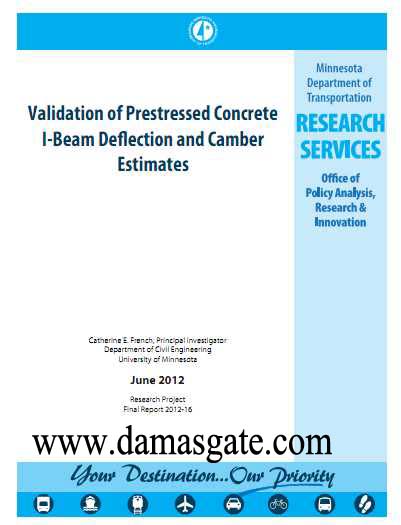Validation of Prestressed Concrete I beam Deflection and Camber Estimates

1.1 Background Camber describes the upward deflection of a girder induced to offset downward
deflection due to self-weight and superimposed loads. In prestressed concrete I-girder applications, camber is achieved by placing high-strength steel strands toward the bottom of the girder, primarily in the bottom flange of the section. The strands are pretensioned to high stresses (usually 0.75*f
=202.5 ksi as specified by the AASHTO LRFD 2010 Bridge Design Specifications). Then, the concrete is cast and allowed to cure until it reaches the design release strength, f’cipu
. The side-forms are then removed and the steel strands are cut. The shortening of the strands, when released, induces compression in the girder. Due to the eccentricity of the strands, the axial compression force in the girder causes it to deflect upwards, and thus, have camber. In this report, the term “camber” will be used to describe the total net deflection of a girder, that is, the upward deflection due to strand eccentricity minus the downward deflection due to self-weight.
Download
*

1.1 Background Camber describes the upward deflection of a girder induced to offset downward
deflection due to self-weight and superimposed loads. In prestressed concrete I-girder applications, camber is achieved by placing high-strength steel strands toward the bottom of the girder, primarily in the bottom flange of the section. The strands are pretensioned to high stresses (usually 0.75*f
=202.5 ksi as specified by the AASHTO LRFD 2010 Bridge Design Specifications). Then, the concrete is cast and allowed to cure until it reaches the design release strength, f’cipu
. The side-forms are then removed and the steel strands are cut. The shortening of the strands, when released, induces compression in the girder. Due to the eccentricity of the strands, the axial compression force in the girder causes it to deflect upwards, and thus, have camber. In this report, the term “camber” will be used to describe the total net deflection of a girder, that is, the upward deflection due to strand eccentricity minus the downward deflection due to self-weight.
Download
*